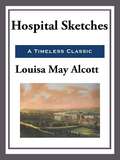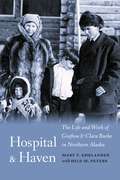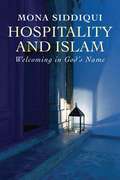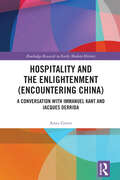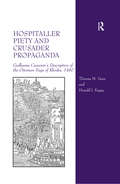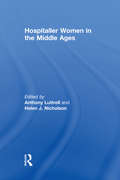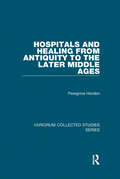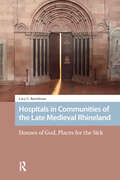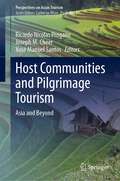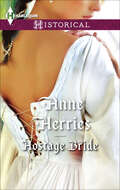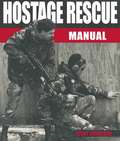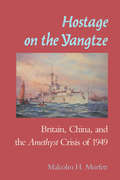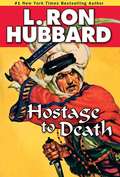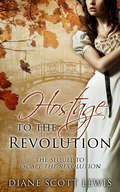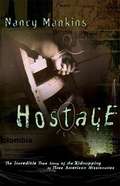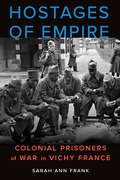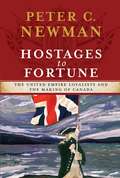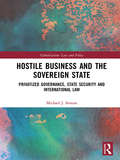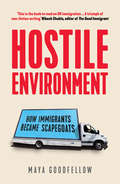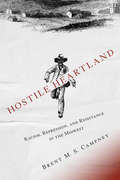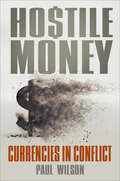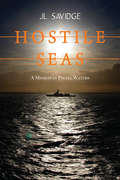- Table View
- List View
Hospital Sketches
by Louisa May AlcottHospital Sketches is a set of sketches based on letters sent by Louisa May Alcott during the six weeks she spent as a nurse for the Union Army in Georgetown.
Hospital and Haven: The Life and Work of Grafton and Clara Burke in Northern Alaska
by Mary F. Ehrlander Hild M. PetersHospital and Haven tells the story of an Episcopal missionary couple who lived their entire married life, from 1910 to 1938, among the Gwich&’in peoples of northern Alaska, devoting themselves to the peoples&’ physical, social, and spiritual well-being. The era was marked by great social disruption within Alaska Native communities and high disease and death rates, owing to the influx of non-Natives in the region, inadequate sanitation and hygiene, minimal law enforcement, and insufficient government funding for Alaska Native health care. Hospital and Haven reveals the sometimes contentious yet promising relationship between missionaries, Alaska Natives, other migrants, and Progressive Era medicine. St. Stephen&’s Mission stood at the center of community life and formed a bulwark against the forces that threatened the Native peoples&’ lifeways and lives. Dr. Grafton (Happy or Hap) Burke directed the Hudson Stuck Memorial Hospital, the only hospital to serve Alaska Natives within a several-hundred-mile radius. Clara Burke focused on orphaned, needy, and convalescing children, raising hundreds in St. Stephen&’s Mission Home. The Gwich&’in in turn embraced and engaged in the church and hospital work, making them community institutions. Bishop Peter Trimble Rowe came to recognize the hospital and orphanage work at Fort Yukon as the church&’s most important work in Alaska.
Hospitality and Islam
by Mona SiddiquiConsidering its prominent role in many faith traditions, surprisingly little has been written about hospitality within the context of religion, particularly Islam. In her new book, Mona Siddiqui, a well-known media commentator, makes the first major contribution to the understanding of hospitality both within Islam and beyond. She explores and compares teachings within the various Muslim traditions over the centuries, while also drawing on materials as diverse as Islamic belles lettres, Christian reflections on almsgiving and charity, and Islamic and Western feminist writings on gender issues. Applying a more theological approach to the idea of mercy as a fundamental basis for human relationships, this book will appeal to a wide audience, particularly readers interested in Islam, ethics, and religious studies.
Hospitality and the Enlightenment: A Conversation with Immanuel Kant and Jacques Derrida (Routledge Research in Early Modern History)
by Anni GreveWith the change of power in Washington, the word ‘Enlightenment’ has taken on a dramatic topicality that no one could have wished for. The wisdom of the eighteenth century could not be more relevant. This book demonstrates a relationship between hospitality towards the foreigner and the European Enlightenment – a relationship that is relevant to today’s landscape.Greve begins by unfolding the philosophy of hospitality by reading both Immanuel Kant and Jacques Derrida. Next, she tunes in on China in global history to discuss: the kind of hospitality offered to all foreigners with the Canton system of 1757; the hospitality offered to Sephardic diaspora groups involved in credit relations; and Macau, a free port city, a rehearsal space for friendship and conversation.Then, the book turns to Copenhagen during the Age of the Enlightenment to look more closely at a burgeoning layer of ‘bourgeoisie’ involved in financial speculation abroad. What significance did the circulation of merchant letters from the Pearl River Delta have for conversations in Copenhagen? It also points to the significance of ‘free’ port cities for the spirit of the Enlightenment.Finally, the book returns to contemporary China. What has the opening of China in the ‘new era’ after Mao Zedong implied? And how do we understand a desire for a ‘New Enlightenment’, first in the late 1980s in Beijing and then in the 2020s in the ‘free’ port city of Hong Kong?The volume is a valuable resource for students and scholars interested in the Enlightenment, diaspora studies, Sephardic Jews, urban studies, philosophy, sociology, and China in global history.
Hospitaller Piety and Crusader Propaganda: Guillaume Caoursin's Description of the Ottoman Siege of Rhodes, 1480
by Theresa M. Vann Donald J. KagayGuillaume Caoursin, the Vice-chancellor of the Order of the Hospital, wrote the Obsidionis Rhodiae urbis descriptio (Description of the Siege of Rhodes) as the official record of the Ottoman siege of the Knights in Rhodes in 1480. The Descriptio was the first authorized account of the Order’s activities to appear in printed form, and it became one of the best sellers of the 15th century. The publication of the Descriptio not only fed Western Europe’s hunger for news about an important Christian victory in the ongoing war with the Turks, it also served to shape public perceptions of the Hospitallers. Caoursin wrote in a humanistic style, sacrificing military terminology to appeal to an educated audience; within a few years, however, his Latin text became the basis for vernacular versions, which also circulated widely. Modern historians recognize the contributions that the Ottoman siege of Rhodes in 1480 made in the development of military technology, particularly the science of fortifications. This book is the first complete modern Latin edition with an English translation of the Descriptio obsidionis Rhodiae. Two other published eyewitness accounts, Pierre D’Aubusson’s Relatio obsidionis Rhodie and Jacomo Curte’s De urbis Rhodiae obsidione a. 1480 a Turcis tentata, also appear in modern Latin edition and English translation. This book also includes John Kay’s Description of the Siege of Rhodes and an English translation of Ademar Dupuis’ Le siège de Rhodes. The lengthy introductory chapters by Theresa Vann place the Ottoman siege of Rhodes in 1480 within the context of Mehmed II’s expansion in the Eastern Mediterranean after he captured Constantinople in 1453. They then examine the development of an official message, or propaganda, as an essential tool for the Hospitallers to raise money in Europe to defend Rhodes, a process that is traced through the chancery’s official communications describing the aftermath of Constantinople and the Ottoman
Hospitaller Piety and Crusader Propaganda: Guillaume Caoursin's Description of the Ottoman Siege of Rhodes, 1480
by Theresa M. Vann Donald J. KagayGuillaume Caoursin, the Vice-chancellor of the Order of the Hospital, wrote the Obsidionis Rhodiae urbis descriptio (Description of the Siege of Rhodes) as the official record of the Ottoman siege of the Knights in Rhodes in 1480. The Descriptio was the first authorized account of the Order’s activities to appear in printed form, and it became one of the best sellers of the 15th century. The publication of the Descriptio not only fed Western Europe’s hunger for news about an important Christian victory in the ongoing war with the Turks, it also served to shape public perceptions of the Hospitallers. Caoursin wrote in a humanistic style, sacrificing military terminology to appeal to an educated audience; within a few years, however, his Latin text became the basis for vernacular versions, which also circulated widely. Modern historians recognize the contributions that the Ottoman siege of Rhodes in 1480 made in the development of military technology, particularly the science of fortifications. This book is the first complete modern Latin edition with an English translation of the Descriptio obsidionis Rhodiae. Two other published eyewitness accounts, Pierre D’Aubusson’s Relatio obsidionis Rhodie and Jacomo Curte’s De urbis Rhodiae obsidione a. 1480 a Turcis tentata, also appear in modern Latin edition and English translation. This book also includes John Kay’s Description of the Siege of Rhodes and an English translation of Ademar Dupuis’ Le siège de Rhodes. The lengthy introductory chapters by Theresa Vann place the Ottoman siege of Rhodes in 1480 within the context of Mehmed II’s expansion in the Eastern Mediterranean after he captured Constantinople in 1453. They then examine the development of an official message, or propaganda, as an essential tool for the Hospitallers to raise money in Europe to defend Rhodes, a process that is traced through the chancery’s official communications describing the aftermath of Constantinople and the Ottoman
Hospitaller Women in the Middle Ages
by Anthony Luttrell Helen J. NicholsonThis volume brings together recent and new research, with several items specially translated into English, on the sisters of the largest and most long-lived of the military-religious orders, the Hospital of St John of Jerusalem. In recent years there has been increasing scholarly interest in women's religious houses during the Middle Ages, with particular focus on the problems which they faced and the social needs which they performed. The military-religious orders have been largely excluded from this interest, partly because it has been assumed that women played little role in religious orders with a predominantly military purpose. Recent research has shown this to be a misconception. Study of the women members of these orders enables scholars to gain a deeper appreciation of the nature of hospitaller and military orders and of the role of women in religious life in general. The papers in this volume explore the roles which the Hospitaller sisters performed within their order; examine the problems of having men and women living within the same or adjoining houses; study relations between the order and the patrons of its women's houses; and consider the career of a prominent Hospitaller woman who became a saint. This volume will be of interest not only to scholars of the military-religious orders and of the Hospital of St John in particular, but also to scholars of monastic history and to those with a concern for women's history during the middle ages.
Hospitallers and Others: Military and Social Encounters (Crusades - Subsidia)
by Christie Majoros Maria Bonet Donato Julia Pavón BenitoThis book features a collection of essays that focus on the Hospitallers’ relations with others through military, social, and political channels within the broader Euro‑Mediterranean region. Centered on Hospitaller settlement and activities in Rhodes and their European priories, this study highlights the various encounters made possible by the far‑reaching and international character of the Order’s activities. In addition to examining Hospitaller encounters and relationships with those outside the Order, this collection also includes essays that explore the internal workings of Hospitaller priories and the Central Convent of the Order during periods of change and expansion, revealing a propensity for continual adaptation and reinvention. Hospitallers and Others: Military and Social Encounters will appeal to scholars and students alike, providing a deeper understanding of the social, military, spiritual, and institutional transformation of the Hospitallers during the medieval period.
Hospitals and Healing from Antiquity to the Later Middle Ages (Variorum Collected Studies)
by Peregrine HordenThe first part of this collection brings together a selection of Peregrine Horden's papers on the history of hospitals and related institutions of welfare provision from their origins in Late Antiquity to their medieval flourishing in Byzantium and the Islamic lands as well as in western Europe. The hospital is seen in a variety of original contexts, from demography and family history to the history of music and the liturgy. The second part turns to the history of healing and medicine, outside the hospital as well as within it. These studies cover a period from Hippocratic times to the Renaissance, but with a particular focus on the Mediterranean region - Byzantine, Middle Eastern and Western - in the Middle Ages.
Hospitals in Communities of the Late Medieval Rhineland (Premodern Health, Disease, and Disability)
by Lucy BarnhouseFrom the mid-twelfth century onwards, the development of European hospitals was shaped by their claim to the legal status of religious institutions, with its attendant privileges and responsibilities. The questions of whom hospitals should serve and why they should do so have recurred — and been invested with moral weight — in successive centuries, though similarities between medieval and modern debates on the subject have often been overlooked. Hospitals’ legal status as religious institutions could be tendentious and therefore had to be vigorously defended in order to protect hospitals’ resources. This status could also, however, be invoked to impose limits on who could serve in and be served by hospitals. As recent scholarship demonstrates, disputes over whom hospitals should serve, and how, find parallels in other periods of history and current debates.
Host Communities and Pilgrimage Tourism: Asia and Beyond (Perspectives on Asian Tourism)
by Joseph M. Cheer Ricardo Nicolas Progano Xosé Manuel SantosThis book delves into topics on pilgrimage travel and communities from a variety of perspectives through academic research based on the Middle East, Northeast Asia, the Indian subcontinent, and Europe, where sacred sites have become of great importance for both international and domestic tourism. In particular, Europe and Asia possess a high volume of world-renowned pilgrimage sites that are currently being developed as tourism destinations in their respective countries, such as Santiago de Compostela (Spain), Lourdes (France), and Koyasan (Japan). This book includes studies on these two continents that harbor both a great history of pilgrimage tradition, as well as tourism development related to religious travel. The book importantly covers the role of the community in religious tourism, as well as the impact on the locals, which is comparatively an unexplored area. Whilst pilgrimage is seen as an effective tool to revitalize local economies, this book also reveals the different challenges to achieving this goal. Realizing the importance of the interrelationship of community and pilgrimage travel, as well as the lack of studies on it, this book seeks to address this research gap through 14 chapters divided into two parts, ‘Communities and Constestation’ and ‘Pilgrimage Shaping Communities’. To ensure diverse perspectives, case studies from different Eurasian countries, written by authors with expertise in the study of pilgrimage and religious travel, are included. Readers can expect to gain new perspectives by having a deeper comprehension of the ‘community side‘ of pilgrimage travel in Eurasia, and thus an integral understanding of contemporary pilgrimage
Hostage Bride
by Anne HerriesCAPTIVE IN THE DARK KNIGHT’S CASTLE...Raphael’s heart is thought to be in the grave with his late wife. He’s certainly thankful for the mission to restore King Richard to the throne; it leaves him with no time for distraction. Lady Rosamunde Meldreth is beautiful, vulnerable, and the prey of a dangerous man. As much as Raphael wants to walk away, he’s forced to keep Rosamunde under lock and key in his castle. Raphael’s interest in Rosamunde seems to be purely one of possession-but then she discovers the dark knight wants to make her his hostage bride...
Hostage Rescue Manual: Tactics of the Counter-Terrorist Professionals, Revised Edition (Hostage Rescue Manual: Tactics Of The Counter-terrorist Professional Ser.)
by Leroy ThompsonA comprehensive illustrated overview of the dynamic operations that have saved lives in hostage situations around the world.Based on strategies proven successful in numerous incidents, including the landmark SAS rescue at Prince’s Gate, London, and compiled by an author with intimate and practical knowledge of the field, this book explains why the success of a rescue is often determined in the hours leading up to confrontation. Once an incident is contained, a large share of the responsibility for a successful conclusion rests with the hostage negotiator, whose job is to save the lives of both hostage and hostage-taker. But if negotiations fail, it becomes necessary to send in the hostage-rescue team to resolve the situation by force and skill. Hostage Rescue Manual explains the complex factors that determine the entry methods undertaken by a team, with discussion of the pros and cons of stealth versus dynamic approaches, plus the significance of distraction in securing successful site entry. Operations in widely differing locations from nuclear power plants to airliners are detailed, as are the range of special weapons available to the men and women tackling each incident. We learn of the multiple roles played by participants, such as the use of snipers as intelligence sources. With vivid photographs and diagrams of rescue units in action, Hostage Rescue Manual is the complete reference work on counter-terrorist procedures all over the world. This revised edition updates the book with an entirely new section devoted to developments in hostage rescue, among them operations in Russia and Iraq, since first publication.
Hostage on the Yangtze
by Malcolm H. MurfettIn 1949, as the Chinese Civil War was about to enter its final, explosive stage, the small British frigate HMS Amethyst was sent on a dangerous mission up the Yangtze River to protect British citizens in Nanking. En route it was attacked by the Chinese Communists and held hostage on the river for several months before the crew managed to make a daring escape.The 'Amethyst' captured news headlines around the world and became an unlikely symbol of the cold war in Asia. This dramatic episode, hailed in the West as a triumph of the human spirit but bitterly condemned by the Chinese Communists, was to prejudice Anglo-Chinese relations for years to come.Using sources not previously available, Malcolm Murfett has written a book that is much more than an account of a single incident. It provides a sweeping survey of British naval power in China, from its faltering and inept beginnings in the late 1630s right up to the establishment of the People's Republic in 1949. In explaining the importance of the Amethyst episode in the history of Anglo-Chinese naval relations, Murfett suggests that it was the final poignant break with the past.Readers will find Hostage on the Yangtze to be a fascinating tale of high adventure, imperialistic oppression, diplomatic shortcomings, and political repercussions - a mixture that culminates in one of the most dramatic and memorable crises of the post-war world.
Hostage to Death
by L. Ron HubbardTriumphant tale of honor and impossible odds. Legionnaire Bill Reilly was given specific orders to guard a railroad station where nightly trains carrying Spanish supplies and troops pass by. He would have done so had it not been for a severed hand that arrived in his camp. The grizzled token carried a taunting message from a renegade Berber chieftain, claiming capture of an Englishwoman named Kay MacArthur and challenging the Legion to rescue her. Reilly's sense of honor overrides all. He takes up the gauntlet knowing full well he could be walking into a trap--with deadly consequences."It's certainly loads of fun." --Ellery Queen* An International Book Awards Finalists
Hostage to the Revolution
by Diane Scott LewisSequel to Escape the Revolution. In 1796, ruined countess Bettina Jonquiere leaves England after the reported drowning of her lover, Everett. In New Orleans she struggles to establish a new life for her children. Soon a ruthless Frenchman demands the money stolen by her father at the start of the French Revolution. Bettina is forced on a dangerous mission to France to recover the funds. She unravels dark family secrets, but will she find the man she lost as well?
Hostage: The Incredible True Story of the Kidnapping of Three American Missionaries
by Nancy MankinsAs missionaries to the Kuna Indians in Pticuro, Panama, Dave and Nancy Mankins were living their dream. After seven years of learning the culture and ministering among the Kuna, the Mankinses had found a home in this small village. then in one terrifying moment their dream was shattered. On January 31, 1993, Colombian rebels burst into their home and captured Dave, along with fellow missionaries Mark Rich and Rick Tenenoff. Helplessly, their wives watched in horror as the three men were seized at gunpoint and taken into the Colombian jungles. In this riveting story, Nancy Mankins collaborates with the other two wives to create a complete account of the events surrounding their husbands’ abduction. From their first day as missionaries in Pucuro to the agonizing years of working tirelessly to gain their husbands’ release, Hostage is the inspiring account of the women’s courage and faith that continues to sustain them through impossible circumstances.
Hostages of Empire: Colonial Prisoners of War in Vichy France (France Overseas: Studies in Empire and Decolonization)
by Sarah Ann FrankHostages of Empire combines a social history of colonial prisoner-of-war experiences with a broader analysis of their role in Vichy&’s political tensions with the country&’s German occupiers. The colonial prisoners of war came from across the French Empire, they fought in the Battle for France in 1940, and they were captured by the German Army. Unlike their French counterparts, who were taken to Germany, the colonial POWs were interned in camps called Frontstalags throughout occupied France. This decision to keep colonial POWs in France defined not only their experience of captivity but also how the French and German authorities reacted to them.Hostages of Empire examines how the entanglement of French national pride after the 1940 defeat and the need for increased imperial control shaped the experiences of 85,000 soldiers in German captivity. Sarah Ann Frank analyzes the nature of Vichy&’s imperial commitments and collaboration with its German occupiers and argues that the Vichy regime actively improved conditions of captivity for colonial prisoners in an attempt to secure their present and future loyalty. This French &“magnanimity&” toward the colonial prisoners was part of a broader framework of racial difference and hierarchy. As such, the relatively dignified treatment of colonial prisoners must be viewed as a paradox in light of Vichy and Free French racism in the colonies and the Vichy regime&’s complicity in the Holocaust. Hostages of Empire seeks to reconcile two previously rather distinct histories: that of metropolitan France and that of the French colonies during World War II.
Hostages to Fortune
by Peter C NewmanEsteemed Canadian author Peter C. Newman recounts the dramatic journey of the United Empire Loyalists—their exodus from America, their resettlement in the wilds of British North America, and their defense of what would prove to be the social and moral foundation of Canada.In 1776, tensions in the British colonies were reaching a fever pitch. The citizenry was divided between those who wished to establish a new republic and those who remained steadfast in their dedication to the British Empire. As the tensions inevitably boiled over into violence, fault lines were exposed as every person was forced to choose a side. Neighbours turned against each other. Families divided. Borders were redrawn. The conflict was long and bloody, and no side emerged unscathed. But there is one story that is often overlooked in the American Revolutionary canon. When the smoke from the battles had settled, tens of thousands of individuals who had remained loyal to the crown in the conflict found themselves without a home to return to. Destitute, distraught, and ostracized—or downright terrorized—by their former citizens, these Loyalists turned to the only place they had left to go: north. The open land of British North America presented the Loyalists with an opportunity to establish a new community distinct from the new American republic. But the journey to their new homes was far from easy. Beset by dangers at every turn—from starvation to natural disaster to armed conflict—the Loyalists migrated towards the promise of a new future. Their sacrifices set the groundwork for a country that would be completely unlike any other. Neither fully American nor truly British, the Loyalists established a worldview entirely of their own making, one that valued steady, peaceful, and pragmatic change over radical revolution. The Loyalists toiled tirelessly to make their dream a reality. And as the War of 1812 dawned, they proved they were willing to defend it with their very lives. In Hostages to Fortune, Peter C. Newman recounts the expulsion and migration of these brave Loyalists. In his inimitable style, Newman shines a light on the people, places, and events that set the stage for modern Canada.
Hostile Business and the Sovereign State: Privatized Governance, State Security and International Law (Globalization: Law and Policy)
by Michael J. StraussThis book describes and assesses an emerging threat to states’ territorial control and sovereignty: the hostile control of companies that carry out privatized aspects of sovereign authority. The threat arises from the massive worldwide shift of state activities to the private sector since the late 1970s in conjunction with two other modern trends – the globalization of business and the liberalization of international capital flows. The work introduces three new concepts: firstly, the rise of companies that handle privatized activities, and the associated advent of "post-government companies" that make such activities their core business. Control of them may reside with individual investors, other companies or investment funds, or it may reside with other states through state-owned enterprises or sovereign wealth funds. Secondly, "imperfect privatizations:" when a state privatizes an activity to another state’s public sector. The book identifies cases where this is happening. It also elaborates on how ownership and influence of companies that perform privatized functions may not be transparent, and can pass to inherently hostile actors, including criminal or terrorist organizations. Thirdly, "belligerent companies," whose conduct is hostile to those of states where they are active. The book concludes by assessing the adequacy of existing legal and regulatory regimes and how relevant norms may evolve.
Hostile Environment: How Immigrants Became Scapegoats
by Maya GoodfellowHow migrants became the scapegoats of contemporary mainstream politicsAs refugees drowned in the Mediterranean, the UK Government proudly announced that the aim of its immigration policy was to create a &‘hostile environment&’ for undocumented immigrants. Despite study after study confirming that immigration is not damaging the economy or putting a strain on public services, migrants continue to be blamed for all the UK&’s ills. How did we get here? Maya Goodfellow offers a compelling answer and illuminates the dark underbelly of contemporary immigration policies. Talking to politicians, immigration lawyers, and immigrants themselves, Goodfellow examines how the media and successive governments have created and fuelled anti-immigration politics over the last fifty years. Ultimately, Hostile Environment reveals the distinct forms of racism and dehumanisation that result from these policies. Goodfellow&’s book is a crucial reminder of the human cost to treating immigration as a problem.
Hostile Heartland: Racism, Repression, and Resistance in the Midwest
by Brent CampneyWe forget that racist violence permeated the lower Midwest from the pre-Civil War period until the 1930s. From Kansas to Ohio, whites orchestrated extraordinary events like lynchings and riots while engaged in a spectrum of brutal acts made all the more horrific by being routine. Also forgotten is the fact African Americans forcefully responded to these assertions of white supremacy through armed resistance, the creation of press outlets and civil rights organizations, and courageous individual activism. Drawing on cutting-edge methodology and a wealth of documentary evidence, Brent M. S. Campney analyzes the institutionalized white efforts to assert and maintain dominance over African Americans. Though rooted in the past, white violence evolved into a fundamentally modern phenomenon, driven by technologies such as newspapers, photographs, automobiles, and telephones. Other surprising insights challenge our assumptions about sundown towns, who was targeted by whites, law enforcement's role in facilitating and perpetrating violence, and the details of African American resistance.
Hostile Money: Currencies in Conflict
by Paul WilsonMoney has the power to make nations and fuel wars. Money is both the subject of diplomacy and the tool of those seeking to overthrow hostile regimes at home and abroad. Germany’s hyperinflation following the First World War has entered the public consciousness as an extreme example of what can happen to a currency in conflict. What is not widely known is that it is by no means the worst case of war-induced hyperinflation. Hostile Money looks at the impact of war and revolution on national currencies – from Rome’s civil war in the first century BC to the twenty-first-century invasions of Afghanistan and Iraq by American-led forces to the economic sanctions and cyber-warfare of the present day. This is a history of money, and so much more.
Hostile Seas: A Mission in Pirate Waters
by Jl SavidgeSet during a period of dramatically escalating piracy, Hostile Seas is a personal account of a mission on board a naval warship in the waters off Somalia. In late 2008, piracy around the Horn of Africa escalated dramatically, threatening the passage of international merchant ships through a critical waterway. Not only were ships carrying goods to North America and Europe affected, but also vessels entrusted with food aid for a Somali population suffering the effects of prolonged drought and civil war.In response, the Canadian government redirected naval frigate HMCS Ville de Québec from the Mediterranean Sea to Somali waters to escort pirate-menaced vessels carrying World Food Programme aid to Mogadishu. Told from the perspective of a ship’s officer, Hostile Seas is a personal account of life on board a deployed navy ship that explores the tension between military imperatives and individual needs as a succession of hijackings brings into focus the reality of Somali piracy.

